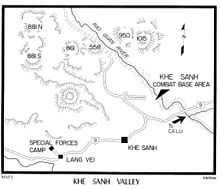Battle for Hill 881
| date | April to May 1967 |
|---|---|
| place | Khe Sanh , South Vietnam |
| output | USA victory |
| Parties to the conflict | |
|---|---|
| losses | |
|
947 dead |
155 dead |
Vietnam War
Battle of Tua Hai (1960) - Battle of Ap Bac (1963) - Battle of Nam Dong (1964) - Tonkin Incident (1964) - Operation Flaming Dart (1965) - Operation Rolling Thunder (1965-68) - Battle of Dong Xoai (1965) - Battle of the Ia Drang Valley (1965) - Operation Crimp (1966) - Operation Hastings (1966) - Battle of Long Tan (1966) - Operation Attleboro (1966) - Operation Cedar Falls (1967) - Battle of Hill 881 (1967) - Battle of Dak To (1967) - Battle of Khe Sanh (1968) - Tet Offensive (1968) - Battle of Huế (1968) - Operation Speedy Express (1968/69) - Operation Dewey Canyon (1969) - Battle of Hamburger Hill (1969) - Operation MENU (1969/70) - Operation Lam Son 719 (1971) - Battle of FSB Mary Ann (1971) - Battle of Quảng Trị (1972) - Operation Linebacker (1972) - Operation Linebacker II (1972) - Battle of Xuan Loc (1975) - Operation Frequent Wind (1975)
The Battle of Hill 881 (April to May 1967) was fought between the Vietnamese People's Army (VVA) and the US Marine Corps and was known in military history as the "Hill Fight".
The battlefields were the strategically important hills 881 north and 881 south north of Khe Sanh . These were two difficult to access volcanic cones , densely overgrown with mountain rainforest , elephant grass and bamboo thicket, which could only be accessed via narrow paths of the Montagnards .
Attempts had already been made in Operation Scotland to take the two hills, but this failed because of insufficient troop strength and lack of preparation.
In April 1967, two battalions of the Marines with approx. 1,400 men under Colonel John P. Lanigan received the order to bind enemy forces of the VVA in their hill positions and to prevent them from conquering Khe San. In addition, the VVA should not be able to set up artillery positions on the hills and take Khe San under fire. Nevertheless, the VVA succeeded in briefly positioning 122 mm field artillery on Hill 881 N and firing shells as far as Khe San. Lanigan had fought in the Battle of Okinawa during World War II , but the majority of his soldiers had no combat experience. The North Vietnamese expected the attack in well-developed bunker positions, which could not be cleared by the American scouts in the tropical vegetation . On Easter Sunday, April 3, 1967, the 3rd Battalion of the 26th Marines attacked Hill 881N and became embroiled in continued and fierce fighting. Hill 881 S was defended by the 18th regiment of the battle-tested 325 VVA C-Division. When the marines reached the ridge of the hill, the VVA fought them like pliers from several sides. In doing so, v. a. K and M companies of the 3rd Marines heavy losses.
VVA shock attacks overran smaller American units, forcing the Marines to call for air strikes for relief and support. B-52 bombers then dropped over 3,250 tons of high explosive and incendiary bombs over the two hills, more than any other single target during the Vietnam War . The heavy bombardment turned both hills into lunar landscapes of bomb craters and red clay, which turned into almost insurmountable morass during tropical downpours.
During the battle there were glaring deficiencies in US tactics and equipment, in particular the failure-prone M16 assault rifle , which replaced or had already replaced the M14 as a handgun used by the Marines. The attack by the Marines on the two hills claimed 155 dead and 455 wounded on the American side. The North Vietnamese buried in their positions lost over 900 soldiers and had to retreat briefly to Laos . Marine Infantry General Victor "Brute" Krulak described the hill fighting as the toughest fighting in the Vietnam War to date .
The hill fighting led to the battle for Khe Sanh .
literature
- Michael P. Kelley: Where We Were In Vietnam . Hellgate Press, 2002, pp. 5-236, ISBN 1-55571-625-3 .
- Edward F. Murphy: The Hill Fights: The First Battle of Khe Sanh
- Arrow of Death . In: TIME Magazine . May 12, 1967
- The Hill Fights South Vietnam, 1967 (archive.org) ( memento March 9, 2009 in the Internet Archive ). In: Robert Pisor: The End of the Line: The Siege of Khe Sahn . 1982.
Web links
- James Epps: Memories of the Hill Battles
- Peter Brush: Battle of Khe Sanh: Recounting the Battle's Casualties

